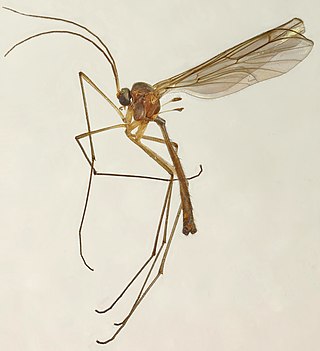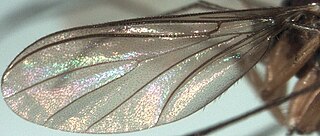
The Nematocera are a suborder of elongated flies with thin, segmented antennae and mostly aquatic larvae. This group is paraphyletic and contains all flies but species from suborder Brachycera, which includes more commonly known species such as the housefly or the common fruit fly. Families in Nematocera include mosquitoes, crane flies, gnats, black flies, and multiple families commonly known as midges. The Nematocera typically have fairly long, fine, finely-jointed antennae. In many species, such as most mosquitoes, the female antennae are more or less threadlike, but the males have spectacularly plumose antennae.

The Nematoceran family Axymyiidae is the sole member of the infraorder Axymyiomorpha, though it is often included within the infraorder Bibionomorpha in older classifications. It is known from only nine species in four genera, plus eight fossil species.

The Mycetophilidae are a family of small flies, forming the bulk of those species known as fungus gnats. About 3000 described species are placed in 150 genera, but the true number of species is undoubtedly much higher. They are generally found in the damp habitats favoured by their host fungi and sometimes form dense swarms.

Sciaroidea is a superfamily in the infraorder Bibionomorpha. There are about 16 families and more than 15,000 described species in Sciaroidea. Most of its constituent families are various gnats.

The Diadocidiidae are a family of flies (Diptera), containing one extant genus with over 20 species and one extinct genus. Diadocidiidae are found worldwide, except in Africa and Antarctica. They are usually considered close to the Keroplatidae, Bolitophilidae, and Ditomyiidae, and used to be included in the Mycetophilidae. They are woodland flies, found in shaded places in forests or near streams. The larvae spin silken tubes under bark or in dead logs, and feed on hymenium of Polyporaceae fungi. The average body length for adults is around 2.5–5.6 mm.

Bolitophila is the sole living genus in the Bolitophilidae, a family of Diptera in the superfamily Sciaroidea, with around 40 Palaearctic and about 20 Nearctic species, and three species from the Oriental region (Taiwan). They are small (6–9 mm).

The Ditomyiidae are a small family of flies (Diptera).They are found worldwide, most species are found in the Australasian and Neotropical realms. There are only two genera in Europe Ditomyia Winnertz, 1846 and Symmerus Walker, 1848 Ditomyia is found in Central Europe Symmerus in Northern Europe Symmerus is endemic to the Palaearctic.
Corynoptera flavosignata is a species of fungus gnat found in the British Isles.
Leptomorphus is a genus of fungus gnats in the family Mycetophilidae. There are about 8 described species in Leptomorphus.
Heteropterna is a genus of predatory fungus gnats in the family Keroplatidae. There are at least 20 described species in Heteropterna.
Lygistorrhina is a genus of long-beaked fungus gnats in the family Lygistorrhinidae. There are at least 20 described species in Lygistorrhina.
Pnyxia scabiei, the potato scab gnat, is a species of dark-winged fungus gnats, insects in the family Sciaridae.
Asiorrhina is a genus of long-beaked fungus gnats in the family Lygistorrhinidae.
Blagorrhina is a genus of long-beaked fungus gnats in the family Lygistorrhinidae.
Gracilorrhina is a genus of long-beaked fungus gnats in the family Lygistorrhinidae.
Labellorrhina is a genus of long-beaked fungus gnats in the family Lygistorrhinidae.
Loyugesa is a genus of long-beaked fungus gnats in the family Lygistorrhinidae.

Rangomaramidae is a family of flies in the infraorder Bibionomorpha. The family, members of which are known as long-winged fungus gnats, was erected in 2002 by Jaschhof and Didham to include five new species of flies in the genus Rangomarama from New Zealand. The family was then expanded to include several other genera from across the world which were formerly classified as Sciaroidea incertae sedis, but preliminary studies show that the broad family is non-monophyletic.
Rocetelion is a genus of flies belonging to the family Keroplatidae.
Manota is a genus of flies belonging to the family Mycetophilidae.








